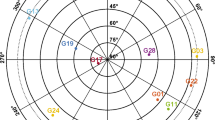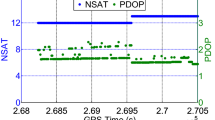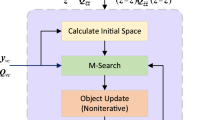Abstract
Global navigation satellite system (GNSS) carrier phase integer ambiguity resolution is the key to high-precision positioning and attitude determination. In this contribution, we develop new integer least-squares (ILS) theory for the GNSS compass model, together with efficient integer search strategies. It extends current unconstrained ILS theory to the nonlinearly constrained case, an extension that is particularly suited for precise attitude determination. As opposed to current practice, our method does proper justice to the a priori given information. The nonlinear baseline constraint is fully integrated into the ambiguity objective function, thereby receiving a proper weighting in its minimization and providing guidance for the integer search. Different search strategies are developed to compute exact and approximate solutions of the nonlinear constrained ILS problem. Their applicability depends on the strength of the GNSS model and on the length of the baseline. Two of the presented search strategies, a global and a local one, are based on the use of an ellipsoidal search space. This has the advantage that standard methods can be applied. The global ellipsoidal search strategy is applicable to GNSS models of sufficient strength, while the local ellipsoidal search strategy is applicable to models for which the baseline lengths are not too small. We also develop search strategies for the most challenging case, namely when the curvature of the non-ellipsoidal ambiguity search space needs to be taken into account. Two such strategies are presented, an approximate one and a rigorous, somewhat more complex, one. The approximate one is applicable when the fixed baseline variance matrix is close to diagonal. Both methods make use of a search and shrink strategy. The rigorous solution is efficiently obtained by means of a search and shrink strategy that uses non-quadratic, but easy-to-evaluate, bounding functions of the ambiguity objective function. The theory presented is generally valid and it is not restricted to any particular GNSS or combination of GNSSs. Its general applicability also applies to the measurement scenarios (e.g. single-epoch vs. multi-epoch, or single-frequency vs. multi-frequency). In particular it is applicable to the most challenging case of unaided, single frequency, single epoch GNSS attitude determination. The success rate performance of the different methods is also illustrated.
Article PDF
Similar content being viewed by others
Avoid common mistakes on your manuscript.
References
Chun C, Park FC (1995) Dynamics-based attitude determination using the global positioning system. J Guid Cont Dyn 24(3): 466–473
Cohen CE, Parkinson BW (1992) Integer ambiguity resolution of the GPS carrier for spacecraft attitude determination. Adv Astronaut Sci 78(8): 91–118
Counselman CC, Gourevitch SA (1981) Miniature interferometer terminals for earth surveying: ambiguity and multipath with the Global Positioning System. IEEE Trans Geosci Remote Sens 19(4): 244–252
Crassidis JL, Markley FL, Lightsey EG (1999) Global positioning system integer ambiguity resolution without attitude knowledge. AIAA J Guid Cont Dyn 22(2): 212–218
Dai L, Ling KV, Nagarajan N (2004) Real-time attitude determination for microsatellite by LAMBDA method combined with Kalman filtering. In: Proceedings 22nd AIAA international communications satellite systems conference and exhibit 2004 (ICSSC), Monterey, California, USA, p 5
DeLorenzo DS, Alban S, Gautier J, Enge P (2004) GPS attitude determination for a JPALS Testbed: integer initialization and testing. In: Proceedings of position location and navigation symposium PLANS 2004, pp 762–770
de Jonge P, Tiberius C (1996) The LAMBDA method for integer ambiguity estimation: implementation aspects. LGR Series 12. Publications of the Delft Geodetic Computing Centre, Delft
Furuno (2003) Model SC-120: Satellite compass. http://www.furunocojp/english/indexhtml
Golub GH, Van Loan CF (1989) Matrix computations, 2nd edn. The Johns Hopkins Univeristy Press, Baltimore
Gomez SF, Lammers ML (2004) Lessons learned from two years of on-orbit global positioning system experience on international space station. In: Proceedings of ION-GNSS, Long Beach, US, p 9
Han S, Rizos C (1999) Single-epoch ambiguity resolution for real-time GPS attitude determination with the aid of one-dimensional optical fiber gyro. GPS Solut 3(1): 5–12
Hatch R (1990) Instantaneous ambiguity resolution. In: Proceedings of KISć690, Banff, Canada, pp. 299–308
Hauschild A, Montenbruck O (2007) GPS based attitude determination for microsatellites. In: Proceedings of ION GPS 2007, p 11
Hauschild A, Grillmayer G, Montenbruck O, Markgraf M, Vorsmann P (2008) GPS based attitude determination for the flying laptop satellite. Small satellites for earth observation. Springer, Netherlands, pp 211–220
Hayward RC, Gebre-Egziabher D, Powell JD (1998) GPS-based attitude for aircraft. In: Proceedings of 5th Saint Petersburg international conference on integrated navigation systems, pp 85–94
Hofmann-Wellenhof B, Lichtenegger H, Collins J (2001) Global positioning system: theory and practice, 5th edn. Springer, Berlin
Hofmann-Wellenhof B, Lichtenegger H, Wasle E (2008) GNSS global navigation satellite systems: GPS, GLONASS, Galileo and more. Springer, Berlin
Juang JC, Huang GS (1997) Development of GPS-based attitude determination algorithms. IEEE Trans Aerosp Electr Syst 33(3): 968–976
Knight D (1994) A new method of instantaneous ambiguity resolution. In: Proceedings of ION-GPS, Colorado Springs, USA, pp 707–716
Kuylen LV, Boon F, Simsky A (2005) Attitude determination methods used in the polarx2@ multi-antenna gps receiver. In: Proceedings of ION GNSS 2005, p 11
Kuylen LV, Nemry P, Boon F, Simsky A, Lorga JFM (2006) Comparison of attitude performance for multi-antenna receivers. Eur J Navig 4(2): 1–9
Leick A (2003) GPS satellite surveying, 3rd edn. Wiley, New York
Li Y, Zhang K, Roberts C, Murata M (2004) On-the-fly GPS-based attitude determination using single- and double-differenced carrier phase measurements. GPS Solut 8: 93–102
Lin D, Voon LK, Nagarajan N (2004) Real-time attitude determination for microsatellite by LAMBDA method combined with Kalman filtering. In: 22nd AIAA international communication satellite systems conference, Monterey, US, p 8
Mader GL (1990) Ambiguity function techniques for gps phase initialization and kinematic solutions. In: Proceedings of 2nd international symposium on precise positioning with the global positioning system, Ottawa, Canada, pp 1233–1247
Misra P, Enge P (2006) Global positioning system: signals, measurements, and performance. Ganga-Jamuna Press, Lincoln
Monikes R, Wendel J, Trommer GF (2005) A modified LAMBDA method for ambiguity resolution in the presence of position domain constraints. In: Proceedings of ION GPS-2005, pp 81–87
Park C, Kim I (1998) Integer ambiguity resolution for GPS based attitude determination system. In: Proceedings of the 37th SICE annual conference, pp 1115–1120
Park C, Teunissen PJG (2003) A new carrier phase ambiguity estimation for GNSS attitude determination systems. In: Proceedings of international GPS/GNSS symposium, Tokyo, p 8
Park C, Kim I, Lee JG, Jee GI (1996) Efficient ambiguity resolution using constraint equation. In: Proceedings of IEEE: position, location and navigation symposium, PLANSć696, Atlanta, Georgia, USA, pp 227–284
Parkinson B, Spilker JJ (1996) GPS: theory and applications, vols. 1, 2. AIAA, Washington
Povalyaev AA, Sorokina IA, Glukhov PB (2006) Ambiguity resolution under known base vector length. In: Proceedings of ION-ITM GNSS, pp 1413–1417
Remondi BW (1990) Pseudo-kinematic GPS results using the ambiguity function method. NOAA Technical Memorandum NOS NGS-52
Strang G, Borre K (1997) Linear algebra, geodesy, and GPS. Wellesley-Cambridge Press, Wellesley
Teunissen PJG (1990) Nonlinear least-squares. Manuscr Geod 15(3): 137–150
Teunissen PJG (1993) Least squares estimation of the integer GPS ambiguities. Invited lecture, Section IV theory and methodology, IAG General Meeting, Beijing (also in: LGR series No6, Delft Geodetic Computing Center, Delft University of Technology)
Teunissen PJG (1995) The least-squares ambiguity decorrelation adjustment: a method for fast GPS integer ambiguity estimation. J Geod 70: 65–82
Teunissen PJG (1998) Success probability of integer GPS ambiguity rounding and bootstrapping. J Geod 72: 606–612
Teunissen PJG (1999) An optimality property of the integer least-squares estimator. J Geod 73(11): 587–593
Teunissen PJG, Kleusberg A (1998) GPS for geodesy, 2nd edn. Springer, Berlin
Tu CH, Tu KY, Chang FR, Wang LS (1996) GPS compass: a novel navigation equipment. IEEE Trans Aerosp Electr Syst 33(3): 1063–1068
Wang B, Miao L, Wang S, Shen J (2009) A constrained LAMBDA method for GPS attitude determination. GPS Solut 13: 97–107
Wang B, Miao L, Wang S, Shen J (2009) An integer ambiguity resolution method for the global positioning system (GPS)-based land vehicle attitude determination. Meas Sci Technol 20: 11
Wang Y, Zhan X, Zhang Y (2007) Improved ambiguity function method based on analytical resolution for GPS attitude determination. Meas Sci Technol 18: 2985–2990
Acknowledgments
The research of the author has been supported by an Australian Research Council Federation Fellowship (project number FF0883188). This support is gratefully acknowledged. He also thanks Gabriele Giorgi and Peter Buist for their numerical and creative contributions to the presented theory.
Open Access
This article is distributed under the terms of the Creative Commons Attribution Noncommercial License which permits any noncommercial use, distribution,and reproduction in any medium, provided the original author(s) and source are credited.
Author information
Authors and Affiliations
Corresponding author
Rights and permissions
Open Access This is an open access article distributed under the terms of the Creative Commons Attribution Noncommercial License (https://creativecommons.org/licenses/by-nc/2.0), which permits any noncommercial use, distribution, and reproduction in any medium, provided the original author(s) and source are credited.
About this article
Cite this article
Teunissen, P.J.G. Integer least-squares theory for the GNSS compass. J Geod 84, 433–447 (2010). https://doi.org/10.1007/s00190-010-0380-8
Received:
Accepted:
Published:
Issue Date:
DOI: https://doi.org/10.1007/s00190-010-0380-8




